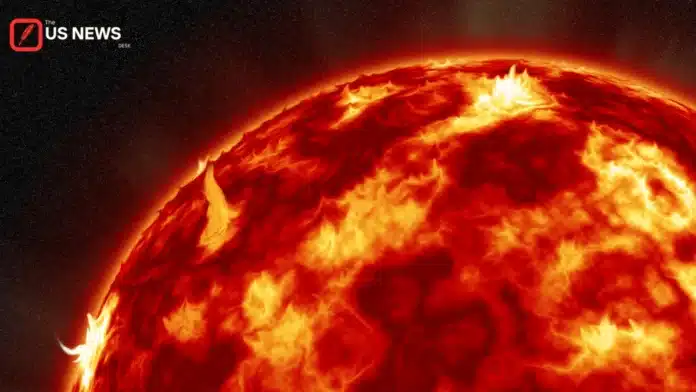Washington, D.C. —
Scientists are sounding the alarm as the Sun enters a heightened period of activity in 2025, with solar physicists predicting one of the most intense flare cycles in decades. While past solar storms have dazzled the skies with auroras, experts warn that this cycle could carry a more serious consequence: widespread disruptions to America’s fragile power grid and communication infrastructure.
The Science Behind the Solar Cycle
The Sun follows an approximately 11-year cycle of activity, swinging between periods of relative calm and high intensity. The current cycle, known as Solar Cycle 25, is now approaching its peak. Researchers at NASA and NOAA note that sunspot activity and coronal mass ejections (CMEs) are already exceeding early projections.
A CME releases billions of tons of charged particles that, if directed toward Earth, can interfere with satellites, power lines, and even underground pipelines. The U.S. has experienced such disruptions before, though not on the scale experts now fear.
A Vulnerable U.S. Power Grid
The U.S. power grid, already under scrutiny for aging infrastructure, is particularly vulnerable. A direct hit from a strong CME could induce powerful electrical currents in long transmission lines, leading to transformer damage and widespread blackouts.
In 1989, a geomagnetic storm knocked out power across Quebec, leaving millions in the dark for nine hours. Experts worry that a similar or stronger event striking the U.S. today could cripple regions far larger, from the Northeast corridor to California.
According to a 2024 report from the Federal Energy Regulatory Commission (FERC), a worst-case scenario could cost trillions of dollars in damages and leave parts of the country without power for weeks. Unlike weather disasters, solar storms provide little time to prepare, giving operators only hours to react after a CME is detected.
Risks Beyond Electricity
The potential damage does not stop at power grids.
- Satellites: Disruptions to GPS navigation, internet services, and weather monitoring could cripple sectors from aviation to agriculture.
- Aviation: Planes flying at high latitudes are at greater risk from radiation surges, forcing reroutes and delays.
- Financial Systems: High-frequency trading and banking networks, reliant on precise timing signals from satellites, could grind to a halt.
“Every modern system, from your smartphone to military operations, depends on technologies that can be affected by space weather,” warned Dr. Elizabeth MacKenzie, a solar physicist at the National Center for Atmospheric Research.
Why 2025 Is Different
What makes 2025 unique is the intersection of intense solar activity and America’s strained infrastructure. The U.S. grid has faced cyberattacks, aging equipment failures, and rising demand from electrification. Adding a solar superstorm into this mix could overwhelm even the most prepared operators.
While NOAA’s Space Weather Prediction Center provides early warnings, scientists admit forecasting remains limited. Unlike hurricanes, which follow visible paths, solar storms can shift direction unpredictably as they travel through space.
Government and Industry Response
Federal agencies are racing to prepare. The Department of Homeland Security has launched initiatives with utility companies to harden critical infrastructure. Some power plants are investing in protective devices known as geomagnetic disturbance (GMD) blockers, which can isolate transformers from harmful currents.
Still, experts caution that preparation remains uneven. Smaller utilities, especially in rural states, often lack resources to implement protections.
A Wake-Up Call for America
For many scientists, Solar Storm 2025 is less about panic and more about preparation. The U.S. has the technology and expertise to mitigate risks, but it requires political will and investment.
“We cannot treat space weather as a distant scientific curiosity,” said Dr. MacKenzie. “It is a national security issue and an economic threat.”




